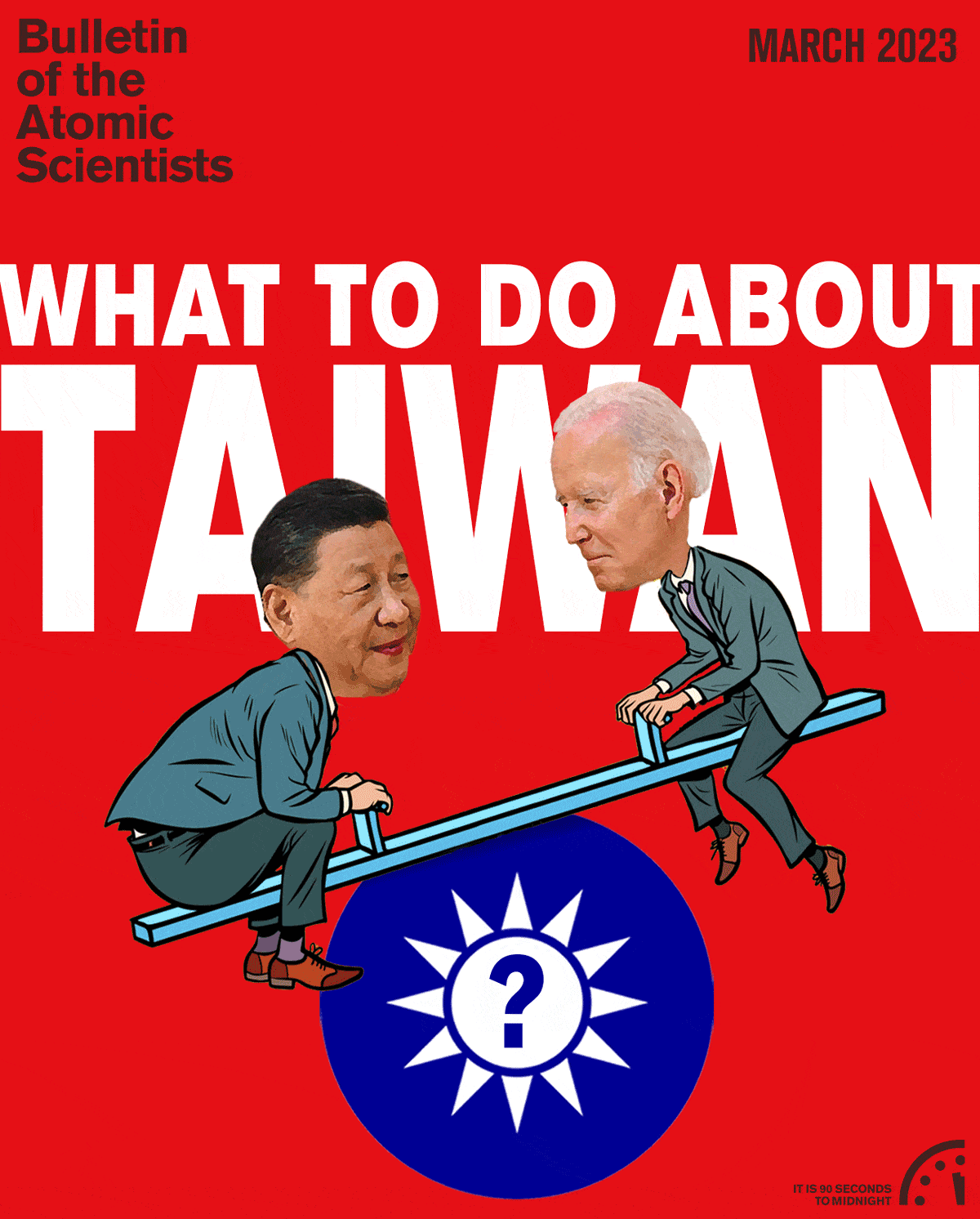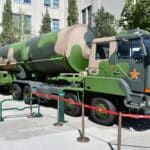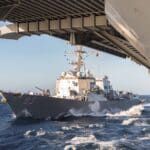Associated Press. 2022. “US Approves $425 Million in Arms Sales to Taiwan.” US News & World Report, December 6. https://www.usnews.com/news/business/articles/2022-12-06/us-approves-425-million-in-arms-sales-to-taiwan
Barranco, J. 2022. Taiwan: The key to containing China in the Indo-Pacific. Washington, DC: The Atlantic Council. December 5. https://www.atlanticcouncil.org/wp-content/uploads/2022/11/Taiwan_the-key-to-containing-China-in-the-Indo-Pacific.pdf
Brunnstrom, D. and Zengerle, P. 2015. “Obama administration authorizes $1.83-billion arms sale to Taiwan.” Reuters, December 16. https://www.reuters.com/article/us-usa-taiwan-arms/obama-administration-authorizes-1-83-billion-arms-sale-to-taiwan-idUSKBN0TZ2C520151217
Bush, R. 2021. Difficult Choices: Taiwan’s Quest for Security and the Good Life Washington, DC: The Brookings Institution.
Campbell, K. and Sullivan, J. 2019. “Competition without Catastrophe: How America Can Both Challenge and Coexist with China.” Foreign Affairs 98(5) (Sept/Oct): 96-111.
Cancian, M., Cancian, M. and Heginbotham, E. 2023. The First Battle of the Next War: Wargaming a Chinese Invasion of Taiwan. Washington, DC: Center for International and Strategic Studies, January. https://csis-website-prod.s3.amazonaws.com/s3fs-public/publication/230109_Cancian_FirstBattle_NextWar.pdf?VersionId=WdEUwJYWIySMPIr3ivhFolxC_gZQuSOQ
Chen, K.T., and Baldock, J. 2022. “US Moves Toward ‘Strategic Clarity’ Reveal Old Rifts in China-US Relations.” The Diplomat, September 22. https://thediplomat.com/2022/09/us-moves-toward-strategic-clarity-reveal-old-rifts-in-china-us-relations/
De Guzman, C. 2023. “Taiwan Is Extending Conscription. Here’s How Its Military Compares to Other Countries.” Time, January 6. https://time.com/6245036/taiwan-conscription-military-comparison/
Glaser, B. 2022. “Nancy Pelosi’s Trip to Taiwan Is Too Dangerous.” New York Times, July 28. https://www.nytimes.com/2022/07/28/opinion/china-us-taiwan-pelosi.html
Goldstein, S. and Schriver, R. 2001. “An Uncertain Relationship: The United States, Taiwan and the Taiwan Relations Act.” The China Quarterly 165 (March): 147-172.
Hansler, J. 2021. “Biden administration proposes $750 million arms sale to Taiwan in a move likely to anger Beijing.” CNN, August 5. https://edition.cnn.com/2021/08/04/politics/biden-administration-taiwan-arms-sales/index.html
Hackett, James (ed). 2022. The Military Balance 2022. London: Routledge for International Institute for Strategic Studies.
Haass, R. and Sacks, D. 2021. “The Growing Danger of U.S. Ambiguity on Taiwan.” Foreign Affairs, December 13. https://www.foreignaffairs.com/articles/china/2021-12-13/growing-danger-us-ambiguity-taiwan
Heginbotham, E., et al. 2015. The US-China Military Score Card: Forces, Geography, and the Evolving Balance of Power, 1996-2017. Santa Monica: RAND.
Kan, S.A.. 2014. Taiwan: Major U.S. Arms Sales Since 1990 Washington, DC: Congressional Research Service, August 29. https://sgp.fas.org/crs/weapons/RL30957.pdf
Kastner, Scott L. 2022. War and Peace in the Taiwan Strait. New York: Columbia University Press.
Kritenbrink, D. 2021. “Statement of Hon. Daniel Kritenbrink, Assistant Secretary of State for East Asian and Pacific Affairs, US Department of State.” The Future of US Policy on Taiwan. Hearing before the Committee on Foreign Relations, United States Senate, 117th Congress, First Session, December 8. https://www.congress.gov/117/chrg/CHRG-117shrg47712/CHRG-117shrg47712.pdf
Kuo, R. 2023. “ ‘Strategic Ambiguity’ Has the U.S. and Taiwan Trapped.” Foreign Policy, January 18. https://foreignpolicy.com/2023/01/18/taiwan-us-china-strategic-ambiguity-military-strategy-asymmetric-defense-invasion/
Lee, J. 2022. “What the Taiwan Relations Act Really Means for US Policy.” Global Asia 17(3) (September): 20-23.
Lee, M. 2022. “US OKs $1B arms sale to Taiwan as tensions rise with China.” AP News, September 3. https://apnews.com/article/taiwan-china-congress-government-and-politics-8901fc7feafbdbfc94e01055a7b1d997
Lin, B., and Wuthnow, J. 2022. “Pushing Back Against China’s New Normal in the Taiwan Strait.” War on the Rocks, August 16. https://warontherocks.com/2022/08/pushing-back-against-chinas-new-normal-in-the-taiwan-strait/
Lin, C. 2021. “US’ Pompeo touts arms sales to Taiwan.” Taipei Times, January 9. https://www.taipeitimes.com/News/taiwan/archives/2021/01/09/2003750238
Mastro, O. 2021. “The Taiwan Temptation: Why Beijing May Resort to Force.” Foreign Affairs 100(4) (July/August): 58-67.
Mazza, M. 2019. “An Assessment of the US Free and Open Indo-Pacific Vision for Taiwan.” American Enterprise Institute, November 20. https://www.aei.org/articles/an-assessment-of-the-us-free-and-open-indo-pacific-vision-for-taiwan/
Morris, L. 2022. “Listening to Xi Jinping on Taiwan.” War on the Rocks, November 18. https://warontherocks.com/2022/11/listen-to-xi-jingping-about-taiwan/
Nouwens, M. 2022. “China’s Military Modernisation: Will the People’s Liberation Army complete its reforms?” in Strategic Survey 2022. London: Routledge for International Institute for Strategic Studies: 53-64.
O’Hanlon, M. 2022. Can China Take Taiwan? Why No One Really Knows. Washington, DC: The Brookings Institution. August. https://www.brookings.edu/wp-content/uploads/2022/08/Can-China-Take-Taiwan-v5.pdf
O’Hanlon, M. 2000. “Why China Cannot Conquer Taiwan.” International Security 25(2) (Fall): 51-86.
Paal, D. 2020. “Taiwan Has Become a Critical Part of Donald Trump’s Anti-China Strategy.” The National Interest(online). August 30. https://nationalinterest.org/blog/reboot/taiwan-has-become-critical-part-donald-trumps-anti-china-strategy-168011
Pettyjohn, S., Wasser, B., and Dougherty, C. 2022. Dangerous Straits: Wargaming a Future Conflict over Taiwan. Washington, DC: Center for a New American Security, June. https://s3.amazonaws.com/files.cnas.org/CNAS+Report-Dangerous+Straits-Defense-Jun+2022-FINAL-print.pdf
Ratner, E. 2021. “Statement of Hon. Ely Ratner, Assistant Secretary of Defense for Indo-Pacific Security Affairs, US Department of Defense.” The Future of US Policy on Taiwan. Hearing before the Committee on Foreign Relations, United States Senate, 117th Congress, First Session, December 8. https://www.congress.gov/117/chrg/CHRG-117shrg47712/CHRG-117shrg47712.pdf
Reuters. 2023. “U.S. four-star general warns of war with China in 2025.” January 28. https://www.reuters.com/world/us-four-star-general-warns-war-with-china-2025-2023-01-28/
Reuters. 2021. “US holds firm on expanding ‘Taiwan’s international space.’ ” South China Morning Post, September 30. https://www.scmp.com/news/china/diplomacy/article/3150706/us-holds-fast-expanding-taiwans-international-space
Rigger, S. 1999. Politics in Taiwan: Voting for Democracy. London and New York: Routledge.
Robertson, N. 2023. “China urges McCarthy not to visit Taiwan.” The Hill, January 30. https://thehill.com/homenews/house/3836382-china-urges-mccarthy-not-to-visit-taiwan/
Saunders, P., et al. 2019. Chairman Xi Remakes the PLA: Assessing Chinese Military Reforms. Washington, DC: National Defense University Press.
Scobell, A. 2003. China’s Use of Military Force: Beyond the Great Wall and the Long March New York: Cambridge University Press.
Sevastopulo, D. 2022. “US allies rattled by China’s aggressive response to Nancy Pelosi’s Taiwan visit.” Financial Times, August 7. https://www.ft.com/content/5462a57a-bd13-4313-b26b-9645b48a70ee
Shelbourne, M. 2021. “Davidson: China Could Try to Take Control of Taiwan In ‘Next Six Years.’ ” USNI News, March 9. https://news.usni.org/2021/03/09/davidson-china-could-try-to-take-control-of-taiwan-in-next-six-years
Snyder, G. 1984. “The Security Dilemma in Alliance Politics.” World Politics 36(4) (July): 461-495.
The White House. 2022. National Security Strategy. October. https://www.whitehouse.gov/wp-content/uploads/2022/10/Biden-Harris-Administrations-National-Security-Strategy-10.2022.pdf
Thompson, D. 2018. “Hope on the Horizon: Taiwan’s Radical New Defense Concept.” War on the Rocks, October 2. https://warontherocks.com/2018/10/hope-on-the-horizon-taiwans-radical-new-defense-concept/
United States Census. n.d. “2022: U.S. trade in goods with Taiwan.” https://www.census.gov/foreign-trade/balance/c5830.html#questions
US-China Economic and Security Review Commission. 2022. Annual Report to Congress. November. https://www.uscc.gov/sites/default/files/2022-11/2022_Annual_Report_to_Congress.pdf.
US Department of Defense. 2022. Military and Security Developments Involving the People’s Republic of China. November. https://media.defense.gov/2022/Nov/29/2003122279/-1/-1/1/2022-MILITARY-AND-SECURITY-DEVELOPMENTS-INVOLVING-THE-PEOPLES-REPUBLIC-OF-CHINA.PDF.
US Department of Defense. 2022. National Defense Strategy of the United States of America. October. https://media.defense.gov/2022/Oct/27/2003103845/-1/-1/1/2022-NATIONAL-DEFENSE-STRATEGY-NPR-MDR.PDF.
Willasey-Wilsey, T. 2022. “US Policy on Taiwan and the Perils of ‘Strategic Ambiguity’.” RUSI, September 26. https://rusi.org/explore-our-research/publications/commentary/us-policy-taiwan-and-perils-strategic-ambiguity.
Wong, E., and Schmitt, E. 2022. “US Speeds Up Reshaping of Taiwan’s Defenses to Deter China.” The New York Times, May 24. https://www.nytimes.com/2022/05/24/us/politics/china-taiwan-military.html.
Yeager, J., and Gerichten, W. 2022. “Reestablish the US Military Assistance Advisory Group-Taiwan.” War on the Rocks, January 7. https://warontherocks.com/2022/01/reestablish-the-u-s-military-assistance-advisory-group-taiwan/.
Zhang, T. 2022. “Risks of War and Paths to Peace across the Taiwan Strait.” Global Asia 17(3) (September): 14-19.
Zhao, S. 2022. “Is Beijing’s Long Game on Taiwan About to End? Peaceful Unification, Brinkmanship, and Military Takeover.” Journal of Contemporary China. Published online September 28. https://doi.org/10.1080/10670564.2022.2124349.
Zheng, S. 2021. “US-China Ties: Competition, Not Engagement from Now On, Kurt Campbell Says.” South China Morning Post, May 27. https://www.scmp.com/news/china/diplomacy/article/3135066/us-china-ties-competition-not-engagement-now-kurt-campbell





















